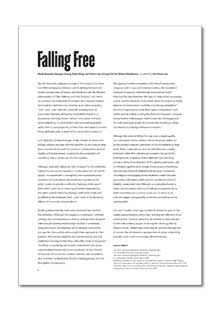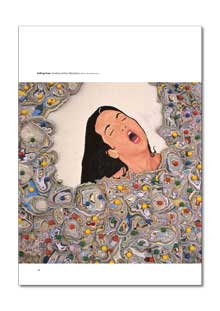 |
|||||||||
|
|
| ...Publications: Annual | ...The Physics Room Annual 2004 | ||||||||||||
|
Falling Free. Mark Boswell, George Chang, Dave King, Jae Hoon Lee, Seung Yul Oh, Rohan Wealleans. Curated by Jae Hoon Lee Identity becomes a slippery concept in the hands of Jae Hoon Lee. With overlapping reference points drifting between the Eastern perspectives of Taoism and Buddhism and the Western philosophies of Gilles Deleuze and Felix Guattari, Lee’s views on existence are defined by fluctuation. He compares Deleuze and Guattari’s definition of a rhizome as an interconnecting “and…and…and” with the constantly growing chain of interlinked identities defined by the Buddhist belief in reincarnation. Similarly, modern physics’ description of matter being defined by its environment and surrounding particles, rather than its own properties, echoes Taoist descriptions of water being definable only in terms of the vessel that contains it. 1 Lee’s digitally combined images of skin, foreign locations and foliage collapse and play with the signifiers of any singular time, place or entity. In his work he constructs conversations around duality and displacement, merging the documentation of experience into a continuum of consciousness. Although ostensibly taking the role of curator for this exhibition, Falling Free can also be viewed as a continuation of Lee’s artistic project. An experiment in multiplicity and improvised group dynamics, the contributors are positioned together by the artist/ curator to provide a collective ‘harmony in the space’. 2 Each artist’s work has its meaning and reality expanded by the wider context offered by dialogue with other works, as if amplified by the Deleuzian “and…and…and” or the harmonic alliance of successive reincarnations.3 Working independently, each artist produced new work for the exhibition. Although this suggests a contingent curatorial strategy that should produce a diverse, perhaps even disparate selection, pre-existing relationships resulted in a relatively integrated result, described by Lee as ‘rampant masculinity’. Lee says he chose artists with a quick-draw approach to their practice, who worked playfully and spontaneously and had established working relationships with other artists in the group. 4 Therefore, it is probably not entirely coincidental that all are male, Auckland-based, and recent graduates of Elam School of Fine Arts.Of course, the curator’s interests and sensibilities also inevitably underpin the decision-making process and the final gallery arrangement. This approach invites comparison with that of experimental composers John Cage and Cornelius Cardew, who assembled musicians to execute indeterminate instructional scores.5 Brian Eno has described how this type of composition encourages variety, and this emphasis on deviation allows the output to fluidly adjust to its environment, much like evolutionary adaptation.6 John Zorn’s game-pieces took these “open compositions” even further, almost entirely eroding the distinction between composer and performer. Following pre-determined rules of engagement, he could participate as part of a community, resulting in a fluid, non-hierarchical dialogue between musicians. 7 Although the works in Falling Free may share a boyish quality, each participant retains a distinct role in the group, unaffected by the curator/composer’s intentions or any resemblance to their peers. There is a disciplinary diversity that allows for complex harmonics within this collective proclamation; Seung Yul Oh’s bleating kinetic sculptures revisit childhood toys; Dave King recruits a heavy metal drummer for the opening and leaves a pile of oversized cigarette butts; George Chang projects thunderous video footage of aircraft; Mark Boswell decorates car bonnets with religious iconography; Rohan Wealleans creates Freudian associations with layered paint; and Lee contributes videos of digitally-manipulated skin. Although accommodated under a single roof, this riotous clamour of male preoccupations has as much consistency as successive circus acts. So much so, an unknown juggler unexpectedly joined the proceedings on the opening night. Like Zorn, Cardew and Cage, Lee likes to loosen his grip on the rudder, acknowledging rather than resisting the influence of his environment. External influences are allowed to alter and add to the code, working as part of an organic whole guided by chance events. Rather than restricting his practice through loss of control, the simultaneous perspectives of group subjectivity provide a sure route to evolving a diversified view. Andrew Clifford 1 Jae Hoon Lee, Doctoral proposal, Auckland University, 2005 2 In conversation with the author, June 2, 2005 3 Jae Hoon Lee, Doctoral proposal, Auckland University, 2005 4 In conversation with the author, June 2, 2005 5 All artists in Falling Free had contact at Elam with New Zealand composer Philip Dadson. 6 Brian Eno, ‘Generating and Organising Variety in the Arts’ Studio International, Nov-Dec 1976, 7 John Zorn, ‘John Zorn’ in Ann McCutchen (ed) The Muse That Sings: View Falling Free. Essay by Andrew Clifford as a PDF This essay originally appeared in The Physics Room Annual 2004 Order your copy today from The Physics Room ! Related 27 January - 21 February, 2004 Falling Free
|
||||||||||||


